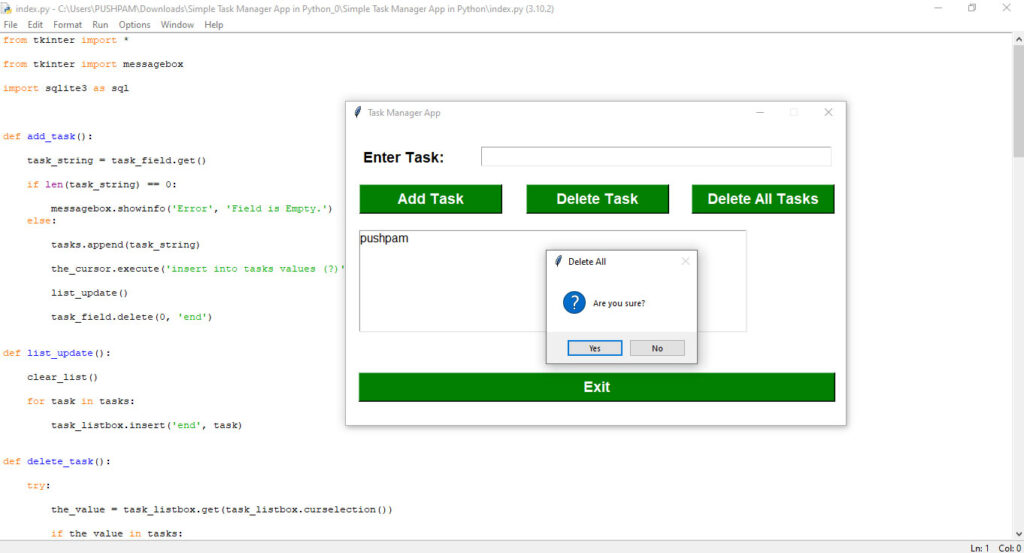
A Task Manager app is a program that allows users to manage their tasks and to-do lists efficiently. In Python, a Task Manager app can be created using various libraries and frameworks, such as Tkinter and more
The app will have a graphical user interface (GUI) with the following features:
- Add Task: Users can add a new task to the list by providing a task name, description, and due date.
- Edit Task: Users can edit the details of an existing task, including the task name, description, and due date.
- Delete Task: Users can delete a task from the list.
- Mark Task as Complete: Users can mark a task as complete.
- View Tasks: Users can view a list of all tasks, including their details such as name, description, due date, and completion status.
The source code for this Task Manager app can be created using the following steps:
- Import the necessary libraries, such as Tkinter and DateTime.
- Create a class for the app that inherits from Tkinter’s Frame class.
- Define the app’s GUI layout using Tkinter’s widgets, such as labels, textboxes, buttons, and list boxes.
- Implement the app’s functionality using Python functions, such as adding, editing, deleting, and marking tasks as complete.
- Integrate the functions with the GUI widgets using Tkinter’s event binding mechanism.
- Create an instance of the app’s class and start the main loop to run the app.
Task Manager App in Python Free Source Code Features
A task manager app in Python can have several features depending on the requirements of the project. Some of the common features that can be included are:
- User Authentication: Users should be able to create an account, log in, and log out of the application. This ensures that only authorized users can access the app.
- Task Creation: Users should be able to create new tasks by providing a name, description, due date, priority, and status. This allows users to keep track of their work and prioritize their tasks.
- Task Management: Users should be able to view, edit, and delete their tasks. The app should also allow users to mark tasks as completed or pending. This helps users to manage their workload efficiently.
- Reminder Notifications: The app should send reminder notifications to users when a task is due. This can be done using email, SMS, or push notifications. This ensures that users do not miss their deadlines.
- Search Functionality: Users should be able to search for tasks using keywords, filters, or tags. This makes it easy for users to find the tasks they are looking for.
- User Interface: The app should have a simple and intuitive user interface. It should be easy to navigate and use, even for users who are not tech-savvy.
- Reporting and Analytics: The app can provide users with reports and analytics about their tasks, such as the number of tasks completed, the time taken to complete tasks, and the percentage of tasks completed on time. This helps users to track their progress and identify areas for improvement.
- Integration with other tools: The app can be integrated with other tools such as calendars, project management software, and productivity apps. This can help users to manage their tasks across different platforms.
- Collaboration: The app can allow users to collaborate on tasks with other users. This can be done by assigning tasks to other users or by allowing multiple users to work on the same task.
- Security: The app should be secure and protect users’ data. This can be done by using encryption, secure authentication mechanisms, and regular backups.
Task Manager App in Python Free Source Code Download & Installation Guide
Here is a general guide on how to download and install a Task Manager App in Python with free source code:
- First, you need to download & install the Python IDLE’s, here’s the link “https://www.python.org/downloads/”.
- Download the source code on this site.
- Locate and Extract the zip file.
- Open the extracted folder
- Locate the py file.
- Then open the file via python IDLE or any IDE that supports python language.
Run the py file to launch the program.
